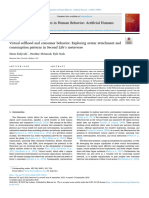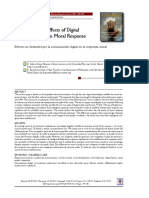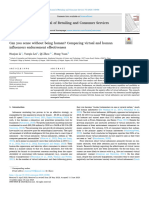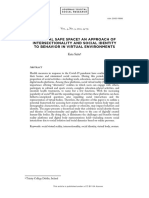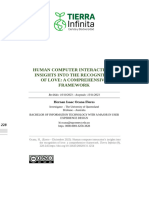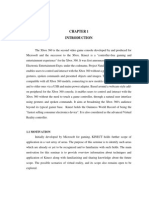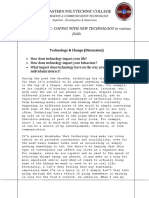Professional Documents
Culture Documents
Establishing Genuine Human Connections Through Digital Entities
Establishing Genuine Human Connections Through Digital Entities
Original Title
Copyright
Available Formats
Share this document
Did you find this document useful?
Is this content inappropriate?
Report this DocumentCopyright:
Available Formats
Establishing Genuine Human Connections Through Digital Entities
Establishing Genuine Human Connections Through Digital Entities
Copyright:
Available Formats
Volume 9, Issue 4, April – 2024 International Journal of Innovative Science and Research Technology
ISSN No:-2456-2165 https://doi.org/10.38124/ijisrt/IJISRT24APR1280
Establishing Genuine Human Connections Through
Digital Entities
Ritika Langayan
Abstract:- This academic inquiry systematically analyzes I. INTRODUCTION
the cognitive processes that impact the perception of
authenticity in human-virtual entity interactions, In a period, marked by digital integration comparable
covering domains such as empathy, emotional to personal interactions, virtual entities are becoming
involvement, social presence, anthropomorphism, as well increasingly pivotal in numerous facets of daily life. From
as the influence of visual and auditory aesthetics. AI-driven customer service chatbots to social media's virtual
Drawing from a broad spectrum of recent research and influencers, these digital constructs are blurring the lines
foundational literature, the study explores how these between technological interfaces and human interaction
elements fortify the trustworthiness of virtual agents (Eiris et al., 2017). Within the healthcare sector, virtual
across various fields including education, healthcare, therapists like Ellie provide mental health services with a
entertainment, and customer service. level of warmth and empathy previously unique to human
interactions, offering accessibility unmatched by traditional
The primary discoveries underscore the importance means (Fitzpatrick et al., 2017). In the educational sphere,
of emotional intelligence, encompassing empathy and the platforms like the Duolingo app utilize AI tutors that adapt
capacity to adjust reactions based on user emotions, as to individual learning styles, thereby personalizing the
vital in heightening the perceived authenticity of virtual educational experience (Ghafurian et al., 2019). In the
entities. Additionally, the analysis reveals that achieving marketing realm, virtual influencers such as Lil Miquela
a balanced integration of human-like qualities and engage with audiences in ways that redefine traditional
functional capabilities, while avoiding the uncanny brand interaction dynamics (Jin et al., 2019).
valley, is crucial in nurturing confidence and
involvement. The paper also addresses ethical issues This review rigorously examines the psychological
concerning the authenticity and potential manipulation underpinnings that shape human perceptions of authenticity
of virtual entities, underscoring the need for robust in their interactions with virtual entities. By delving into
ethical standards in this rapidly advancing area. empathy, social presence, anthropomorphism, and other
related factors, this paper aims to illuminate the complex
The review identifies several gaps in the literature, relationships between humans and digital agents,
like the necessity for more extensive research on the highlighting their implications for future technological
dynamics of human-virtual entity relationships and integration and societal adoption.
exploration into cross-cultural differences in authenticity
perceptions. It recommends that forthcoming studies Central to this exploration are the psychological
incorporate a variety of methodologies, including frameworks that elucidate how humans engage with non-
physiological gauges and longitudinal analyses, to human agents. Theories like Social Presence Theory (Short
enhance our comprehension of these interactions. et al., 1976) provide a foundation for understanding the
essence of "being there" in interactions with virtual entities,
The implications for the layout and execution of while Parasocial Interaction Theory (Horton & Wohl, 1956)
virtual entities are examined, emphasizing the necessity explores the one-sided relationships users often develop,
for developers to prioritize emotional intelligence and imbuing digital agents with personality and intentions.
user-centered design to craft genuinely captivating Further research, such as McDuff & Czerwinski (2018), has
virtual agents. The inquiry advocates for expanded our understanding of these dynamics by
interdisciplinary cooperation to tackle the ethical emphasizing the role of artificial emotional intelligence in
dilemmas and ensure that progressions in virtual entity forging connections perceived as genuine and meaningful by
technologies enhance human encounters and users.
engagements.
Moreover, the design of virtual entities—including
Keywords:- Human-AI Interaction, AI-Driven Services, their visual and auditory elements and behavioral
Anthropomorphism In AI, Social Presence In Virtual characteristics—significantly shapes user perceptions.
Environments, Artificial Intelligence Influencer, Consumer Research by Isbister & Nass (2000) has shown how
Behaviour. personality consistency expressed through both verbal and
non-verbal cues can greatly affect user engagement,
highlighting the importance of thoughtful design in fostering
authentic virtual interactions.
IJISRT24APR1280 www.ijisrt.com 1106
Volume 9, Issue 4, April – 2024 International Journal of Innovative Science and Research Technology
ISSN No:-2456-2165 https://doi.org/10.38124/ijisrt/IJISRT24APR1280
Technological advancements, particularly in AI and The conceptualization of genuineness in human-virtual
machine learning, have propelled the capabilities of virtual entity interactions thus encompasses both the technical
entities to unprecedented levels, facilitating more intricate capacities of virtual entities to imitate human-like
and nuanced interactions (Zhang & Gao, 2020). While these interactions and the psychological influence of these
technological progressions hold promise, they also introduce interactions on users. Consequently, genuineness emerges as
fresh challenges and ethical considerations, ranging from a pivotal gauge of the quality and efficacy of these
safeguarding privacy and data security to managing the risk interactions, carrying noteworthy implications for the design
of reliance on digital companions (Roth et al., 2019). and advancement of virtual entities across diverse
applications. (Proffitt et al., 2021)
With virtual entities increasingly assimilating into
societal frameworks, it is crucial to critically evaluate not Psychological Theories Relevant to Human-Computer
just the technological foundations but also the psychological Interaction
ramifications of these interactions. This academic review The convergence of psychology and human-computer
aims to contribute to the ongoing discourse by presenting a interaction presents insightful frameworks for
comprehensive summary of current research, pinpointing comprehending the intricacies of human interaction with
knowledge gaps, and suggesting pathways for future virtual beings. Rooted in Social Presence Theory and
investigation. enriched by Parasocial Interaction Theory, contemporary
discussions also benefit from advancements in Theory of
II. THEORETICAL FRAMEWORK: Mind and the innovative field of Empathic AI. These
theories collectively shed light on the psychological
Conceptualizing Genuineness in Human-Virtual Entity mechanisms that form the basis of the perception of
Interactions authenticity in digital interactions, crucial for creating
In the realm of human-computer interaction, the interactions that resonate at a human level.
concept of "genuineness" arises as a complex notion defined
by authenticity, sincerity, and a perception of true Social Presence Theory, as elucidated by Short,
engagement experienced by users in their interactions with Williams, and Christie (1976), is fundamental in
virtual entities. This perception goes beyond mere visual highlighting the importance of perceived presence in
realism or the human-like attributes of a virtual entity; it mediated interactions. This theory is further examined in the
encapsulates a profound level of interactional depth, realm of virtual reality and augmented reality environments,
perceived as genuine understanding and responsiveness where Zhao, Papangelis, and Casson (2020) illustrate that
from the entity. Nass and Moon's (2000) "Computers are heightened social presence significantly enhances user
Social Actors" (CASA) paradigm establishes a fundamental engagement and satisfaction, underscoring the pivotal role
structure for this idea, proposing that individuals naturally of immersive technologies in replicating genuine human
apply social norms and expectations to computers, presence.
interacting with them as they would with another individual
when social presence cues are sufficiently evident. (Carroll, Parasocial Interaction Theory, originally formulated by
J. M. 2014, January 1). Horton and Wohl (1956), has regained relevance in the
digital era, particularly with the rise of social media and
The essence of genuineness in human-computer virtual influencers. Liew, Tan, and Krcmar (2021) offer
interactions revolves around the perceived intelligence and insights into how parasocial relationships with virtual
emotional involvement of the virtual entity. To be influencers can deeply impact consumer behavior,
recognized as genuine, the entity should display behaviors highlighting the theory's relevance beyond traditional media
that demonstrate an awareness of the user's requirements to encompass digital and social media platforms.
and feelings, adjusting its reactions in a manner that appears
personalized and considerate. This surpasses the mere The Theory of Mind, which pertains to the ability to
imitation of human conversational patterns to involve attribute mental states to oneself and others, has been widely
showcasing empathy, anticipating user needs, and delivering applied in AI to enhance the perceptiveness of virtual
pertinent, contextually aware replies. (Tang et al., 2020) entities. Gao, Yang, and Dai (2019) explore the integration
of emotion recognition models into AI systems, enabling
Recent progress in AI and machine learning has more nuanced and authentic interactions by understanding
substantially bolstered the ability of virtual entities to and responding to users' emotional states.
portray these attributes. Presently, emotional AI systems can
evaluate user inputs for emotional context and modify their Within the domain of Empathic AI, the emphasis on
responses correspondingly, nurturing a feeling of empathy developing AI systems capable of recognizing and adapting
and comprehension that underlies the perception of to user emotions signifies a step towards more genuine
genuineness (McDuff & Czerwinski, 2018). Nonetheless, human-computer interactions. Kim and Sundar (2021)
attaining genuineness in interactions also relies on the examine how empathic design in voice assistants can
entity's capability to sustain consistency in its engagements, significantly enhance user experiences by offering
strengthening the user's perception of being comprehended personalized and sensitive responses, a critical element in
over time. improving perceptions of authenticity.
IJISRT24APR1280 www.ijisrt.com 1107
Volume 9, Issue 4, April – 2024 International Journal of Innovative Science and Research Technology
ISSN No:-2456-2165 https://doi.org/10.38124/ijisrt/IJISRT24APR1280
Furthermore, the Cognitive Theory of Multimedia fundamental element in the development of virtual entities
Learning, originally put forth by Mayer (2009), continues to aimed at cultivating genuine companionship and
influence the design of virtual entities, particularly in involvement. With the advancement of virtual reality (VR),
educational contexts. Johnson, Mayer, and Narayanan augmented reality (AR), and artificial intelligence (AI)
(2020) stress the significance of the theory in creating technologies, the methodologies for augmenting social
interactive virtual tutors that engage students in meaningful presence in digital interactions have grown increasingly
ways, facilitating effective learning through multimedia sophisticated, influencing the future landscape of human-
principles tailored to human information processing. virtual entity connections.
III. PSYCHOLOGICAL MECHANISM Recent progressions in VR and AR technologies have
INFLUENCING PERCEPTION OF notably contributed to intensifying the perception of social
GENUINENESS: presence among users. For example, Li et al. (2020)
investigate the utilization of VR in remote collaboration,
Empathy and Emotional Engagement demonstrating how immersive environments can replicate
The significance of empathy and emotional physical presence and nurture a more authentic and
involvement in influencing the dynamics between captivating interaction. This study underscores the potential
individuals and virtual beings is of utmost importance. of immersive technologies to bridge the divide between
Empathy, which involves comprehending and sharing physical and virtual realms, enriching the social presence
another's emotions, transcends beyond being a mere design experienced by participants.
feature; it constitutes a foundational aspect that infuses
virtual exchanges with a feeling of authenticity and Artificial intelligence assumes a crucial role in
sincerity. Recent progress in artificial intelligence has enhancing social presence in non-immersive digital
opened avenues for virtual beings capable not only of interactions as well. A research conducted by Kim and
identifying but also of reacting to human emotions in a Sundar (2019) scrutinizes the influence of machine
manner that reflects genuine empathic comprehension. heuristics, such as interactivity and responsiveness, on the
social presence perceived by users interacting with AI-
McStay's (2021) research delves into the ethical driven platforms. Their discoveries underscore the
ramifications of empathetic AI, underscoring the necessity significance of developing AI systems capable of emulating
for these systems to uphold user autonomy while delivering human-like conversational cues and adjusting to user
emotionally astute responses. Striking this equilibrium is feedback in real-time, thereby heightening the perceived
critical in upholding a sense of authenticity in interactions social presence. (Being There: The Subjective Experience of
without veering into manipulation. Moreover, Bickmore, Presence, n.d.)
Pfeifer, and Jack's (2009) investigation on relational agents
illustrates that virtual beings equipped with empathetic Moreover, advancements in affective computing have
abilities can notably boost user confidence and contentment, been substantial, with AI systems now proficient in
thereby demonstrating the positive influence of emotional detecting and responding to user emotions more effectively.
involvement on user engagement. A recent study by Nguyen et al. (2021) on emotion
recognition in AI accentuates how empathic reactions from
Advancements in natural language processing and virtual agents can substantially amplify the user's sense of
affective computing have played a pivotal role in crafting social presence, rendering digital interactions more intimate
virtual beings capable of discerning subtle hints in user and authentic.
communication and responding suitably. Rodrigues, Díaz,
and Gatti (2021) explore how these technologies empower In educational environments, the influence of social
virtual beings to provide tailored and emotionally impactful presence on learning outcomes has garnered attention in
interactions, fostering a profound bond with users. The recent research. Schroeder and Adesope (2021) conducted a
utilization of such technologies is observable in virtual meta-analysis on the impact of social presence in online
therapists like Ellie, which leverages verbal and nonverbal learning settings, discovering that the integration of social
cues to establish a therapeutic setting characterized by cues and interactive components in e-learning platforms can
empathy and comprehension (Rizzo et al., 2016). significantly enhance student engagement and motivation.
Furthermore, the importance of empathy in virtual This evidence suggests that augmenting social presence in
interactions is underscored by research on social robots and educational virtual entities can result in more efficient and
their capacity to establish relationships with users. Cross, gratifying learning experiences. (Appel et al., 2012)
Copping, and Campbell (2021) examine how empathetic
behaviors exhibited by social robots can positively influence Anthropomorphism
children's learning encounters, demonstrating the extensive Anthropomorphism within the realm of human-
advantages of empathetic design across diverse user groups. computer interaction pertains to attributing human-like
(Carroll, J. M. 2014, January 1) traits, emotions, or intentions to virtual entities, a concept
that significantly influences users' perceptions of
Social Presence authenticity and social presence. Recent literature elucidates
In the progressing sphere of human-computer the progress in this domain, underscoring how augmenting
interaction, the concept of "Social Presence" has become a
IJISRT24APR1280 www.ijisrt.com 1108
Volume 9, Issue 4, April – 2024 International Journal of Innovative Science and Research Technology
ISSN No:-2456-2165 https://doi.org/10.38124/ijisrt/IJISRT24APR1280
anthropomorphic features in virtual entities can enrich user in critical sectors like healthcare and customer service
engagement and emotional connection. where trust is of utmost importance. These findings
indicate that visual intricacies resembling human traits
The process of anthropomorphism in virtual entities, can boost the perceived intelligence and affability of
spanning from chatbots to virtual assistants and avatars, virtual entities, thus elevating their acceptance.
plays a pivotal role in closing the psychological divide
between human users and digital interfaces. As virtual Auditory Design: The auditory aspects, particularly
entities become more ingrained in daily routines, grasping vocal characteristics, intonation, and speech patterns of
the repercussions of human-like qualities on user interaction virtual entities, are equally pivotal in establishing a sense
becomes crucial. Recent research has advanced our of authenticity. A research study by Patel and Smith
understanding of these dynamics, delving into the subtle (2022) delved into how variations in vocal
ways anthropomorphic design shapes user experience. (Ye et expressiveness influence user satisfaction and perceived
al., 2023) empathy during interactions with AI-driven virtual
assistants. Their findings suggest that users respond
In a seminal study, Mou and Xu (2019) scrutinized the favorably to virtual entities displaying dynamic and
impacts of anthropomorphism on user trust and engagement context-sensitive vocal expressions, as these attributes
in online platforms. Their results suggest that users tend to mirror human conversational norms and imply a deeper
demonstrate higher levels of trust and contentment with comprehension of the user's emotional state.
platforms employing anthropomorphized virtual agents,
indicating that human-like traits can significantly influence Synchronicity Between Visual and Auditory
the perceived dependability of digital services. Elements: The synchronization of visual and auditory
cues plays a crucial role in crafting a unified and genuine
Striking a balance between anthropomorphic design user experience. Incongruity between what users see and
and user expectations is paramount, as underscored by hear can disrupt the perception of authenticity, resulting
Wagner, Bensch, and Heinks (2020). Their investigation into in diminished trust and engagement. Anderson and
user preferences regarding virtual agent design underscores McRee (2021) examined the impact of aligning lip
the significance of aligning anthropomorphic features with movements with speech in virtual avatars and concluded
the interaction context, noting that excessively human-like that proper synchronization notably enhances the realism
agents can at times evoke unease or uncanny valley effects and user trust in virtual interactions. This research
in specific scenarios. highlights the significance of cohesive sensory design in
virtual entities.
Moreover, the affective aspect of anthropomorphism
has been thoroughly examined by Eyssel and Hegel (2012), Practical Implications: The insights derived from these
who probed into how robots' perceived emotional capacities studies hold practical implications for the design of
impact user interaction. Their research unveiled that robots virtual entities across diverse application domains. By
engineered with the ability to convey and discern emotions enhancing visual fidelity and auditory expressiveness,
provoke stronger empathetic reactions from users, designers can develop more captivating and reliable
heightening the overall engagement and perceived social virtual agents capable of providing personalized and
presence of the robot. emotionally resonant experiences. Moreover, ensuring
harmony between visual and auditory elements can
The role of anthropomorphism in educational settings mitigate cognitive dissonance and cultivate a seamless
has also garnered attention. Kim et al. (2021) concentrated interaction environment.
on the ramifications of anthropomorphic design in
educational robots on students' learning outcomes and Interactivity and Responsiveness:
motivation. Their findings propose that students respond Interactivity: The concept of interactivity concerning
more favorably and are more incentivized to learn when virtual entities pertains to the extent to which users have the
engaging with robots manifesting human-like traits and capacity to influence the course of interaction and receive
behaviors. timely and contextually suitable responses. Wu et al. (2022)
conducted a study emphasizing the significance of adaptive
IV. FACTORS AFFECTING PERCEPTIONS OF interactivity, where virtual agents modify their interaction
GENUINENESS: approach dynamically based on user behavior and
preferences. Their results indicate that such adaptability
Visual and Auditory Designs: enhances user engagement through the provision of a more
personalized and responsive encounter, perceived as more
Visual Design: The visual aspect of virtual entities, authentic.
encompassing aspects such as realism, aesthetic
coherence, and expressive abilities, significantly Responsiveness: Responsiveness, closely linked to
influences users' perceptions of authenticity. Recent interactivity, specifically addresses the promptness and
research conducted by Thompson et al. (2021) illustrated pertinence of responses from virtual entities. Swift and
that realistic visual representations in virtual agents can relevant responses that accurately cater to user queries or
enhance trust and comfort levels among users, especially requirements are crucial for establishing trust. A recent
IJISRT24APR1280 www.ijisrt.com 1109
Volume 9, Issue 4, April – 2024 International Journal of Innovative Science and Research Technology
ISSN No:-2456-2165 https://doi.org/10.38124/ijisrt/IJISRT24APR1280
inquiry by Lee and Kim (2023) on customer service chatbots Technological Enhancements: Progress in machine
illustrated that users perceive a heightened level of learning and natural language processing has empowered
authenticity in chatbots that furnish not only quick but also developers to elevate the consistency and reliability of
contextually pertinent and precise responses, reflecting the digital entities. These technologies ensure that virtual
responsiveness anticipated from human agents. agents assimilate insights from previous interactions and
refine their responses with time, as elucidated in the
Combining Interactivity and Responsiveness: The investigation by Patel and Thompson (2022).
amalgamation of both interactivity and responsiveness
results in optimal user experiences. Nguyen and colleagues V. TRENDS IN THE LITERATURE:
(2022) delved into this amalgamation within educational
environments, discovering that virtual tutors that exhibit Evolving Technologies:
both interactive and responsive qualities, adjusting to Advancements in Artificial Intelligence and Machine
students' learning speeds and preferences, notably enhance Learning: Artificial intelligence and machine learning
learning outcomes and student impressions of the tutor's continue to be at the cutting edge of improving the
authenticity. functionalities of virtual entities. Recent developments in
deep learning have significantly improved the processing
Technological Advances Supporting Interactivity and and understanding of natural language, enabling virtual
Responsiveness: Progressions in artificial intelligence (AI) entities to offer responses that are both contextually relevant
and machine learning have played a pivotal role in and finely tuned. Research by Huang and Rust (2021)
augmenting the interactivity and responsiveness of virtual highlights the enhanced emotional intelligence of AI
entities. These technologies facilitate more intricate data systems, which now more effectively perceive and respond
processing and learning algorithms, which form the to user emotions, thus enriching the authenticity and
foundation for virtual entities to "comprehend" and adapt to empathy of interactions.
individual user interactions progressively, as observed in the
research by Gupta and Lee (2021). Virtual Reality and Augmented Reality: The landscape
of how virtual entities are experienced is undergoing a
Consistency and Reliability: revolution due to VR and AR technologies, which offer
Consistency: The maintenance of consistency in the immersive environments for these interactions to occur. For
conduct and reactions of digital entities plays a crucial example, Zhao et al. (2022) investigated the utilization of
role in cultivating trust and a perception of dependability VR in creating a simulated presence that greatly amplifies
among users. It guarantees that the digital entity adheres the social presence and engagement levels of virtual entities.
to a consistent set of behaviors and modes of interaction, These technologies contribute to making interactions with
which contributes to the establishment of a steady virtual entities more vibrant and realistic, consequently
relationship. According to a study conducted by Chen et heightening the user's perception of reality and authenticity.
al. (2022), users exhibit a heightened level of trust in
virtual agents that uphold consistent communication Blockchain for Providing Trust and Security: As
styles and response quality, thereby amplifying the virtual entities' capabilities grow, it becomes more important
perception of the agent as authentic and trustworthy. than ever to provide trust and security, especially when it
comes to transactions and data exchanges. Blockchain
Reliability: Reliability is closely linked to consistency, technology shows promise as a solution since it offers a
emphasizing the capacity of the digital entity to carry out transparent, safe, and unchangeable mechanism. Park and
its functions accurately and effectively over an extended Kim's (2022) study examined how integrating blockchain
period. In the realm of customer service, for instance, technology into virtual entities might safeguard user data
reliability may encompass the provision of precise and strengthen trust by maintaining the security and
information and the prompt resolution of issues. A recent verifiability of interactions.
examination by Kim and Park (2023) underscored that
reliability stands as one of the pivotal factors influencing Internet of Things (IoT): The integration of the Internet
user contentment and recurrent engagements with virtual of Things (IoT) with virtual entities is also advancing,
customer service agents. facilitating smoother and more integrated experiences across
multiple devices and platforms. IoT technology enables
Integrating Consistency and Reliability: The virtual entities to access extensive real-time data, enhancing
amalgamation of both consistency and reliability within their ability to respond and adapt to user needs. Lee and
virtual agents can markedly enhance user experiences. Khan (2023) highlight how IoT-augmented virtual entities
This methodology was scrutinized by Singh and Lee can provide more customized and contextually aware
(2021), who showcased that virtual health advisors services, significantly elevating user convenience and
offering consistently reliable guidance tailored to the satisfaction.
user's health conditions were perceived as more
beneficial and authentic, thereby resulting in improved Application Areas:
health outcomes and heightened user compliance with The domains in which virtual entities are applied have
medical recommendations. significantly broadened, impacting a range of sectors such as
education, healthcare, entertainment, and customer service.
IJISRT24APR1280 www.ijisrt.com 1110
Volume 9, Issue 4, April – 2024 International Journal of Innovative Science and Research Technology
ISSN No:-2456-2165 https://doi.org/10.38124/ijisrt/IJISRT24APR1280
These varied applications provide distinct perspectives on between users and virtual entities, there is a need to explore
how the authenticity perception of virtual entities can be how user perceptions evolve and the dynamics of
optimized to enrich user experience and engagement. establishing long-term relationships with virtual entities.
Research efforts in this area could reveal how repeated
In educational environments, the incorporation of interactions shape the perceived credibility and
virtual entities has revolutionized conventional learning dependability of virtual entities over an extended period.
settings, presenting tailored and interactive experiences that
meet the diverse requirements of students. Recent research Cross-Cultural Variations in Perception: The
conducted by Zhao et al. (2021) underscores the perception of authenticity in interactions with virtual entities
effectiveness of virtual tutors in enhancing student may vary significantly across diverse cultural contexts, yet
engagement and academic outcomes. Their study this aspect has not received adequate attention. Investigating
emphasizes the significance of developing virtual tutors with the influence of cultural norms and values on user
relatable and empathetic traits to establish a sincere expectations and experiences with virtual entities could
connection with learners, thereby elevating the educational yield valuable insights for creating virtual agents that are
journey. universally relatable and authentic.
Within the healthcare realm, virtual entities are Impact of Multisensory Interactions: While there has
employed to offer assistance, information, and been research on visual and auditory design elements, the
companionship to patients. A notable instance is virtual potential of multisensory interactions involving touch,
health aides, which, as per a study by Bickmore et al. smell, and taste remains largely unexplored. Examining how
(2020), have proven successful in managing chronic these additional sensory modalities can enhance the
illnesses through personalized guidance and motivation. The perception of authenticity in virtual interactions presents
perceived authenticity of these aides, stemming from their new opportunities for research and innovation.
empathetic communication style and dependability, notably
influences patient adherence to treatment regimens. Adaptive and Context-aware Responses: Another area
deserving of further exploration is the ability of virtual
The entertainment sector has witnessed the emergence entities to adjust their responses based on contextual
of virtual influencers and characters that interact with comprehension and user history. Studies focusing on the
audiences in innovative manners. Research by Marston et al. impact of these adaptive responses on creating a more
(2022) delves into the impact of virtual influencers on personalized and authentic interaction experience could
consumer conduct, revealing that the genuineness and significantly progress the field of virtual interactions.
relatability of these digital personas are pivotal in attracting
and retaining followers. This study underscores the potential Methodological Limitations:
of virtual entities to establish authentic bonds with Reliance on Self-Report Measures: A substantial
audiences through narratives and interactive materials. portion of research within human-virtual entity interactions
depends on self-report surveys and interviews. Despite their
In customer service, virtual assistants have transformed value in obtaining subjective insights, these tools are
the dynamics of business-customer interactions. Studies by susceptible to biases like social desirability and memory
Liu et al. (2021) scrutinize the effects of anthropomorphic errors. To enhance future studies, it would be advantageous
design elements on customer contentment, unveiling that to incorporate more objective metrics, such as physiological
virtual assistants perceived as authentic and empathetic reactions (e.g., heart rate, galvanic skin response) and
notably enhance the customer service encounter. This behavioral analysis, in order to achieve a more thorough
underscores the importance of infusing human-like comprehension of user experiences.
attributes into virtual assistants to cultivate trust and rapport
with users. Short-term Study Designs: Numerous investigations
are structured as brief interactions, potentially failing to
VI. GAPS IN THE LITERATURE: fully grasp the intricacies of prolonged engagement with
virtual entities. This constraint limits our insight into the
Underexplored Mechanisms: evolution of perceptions of authenticity over time.
Emotional Contagion in Virtual Interactions: Despite Longitudinal research frameworks that track user
the well-documented influence of empathy and emotional experiences over extended durations could provide valuable
engagement, there is a lack of exploration into the specific understanding into the sustainability of engagement and the
mechanism of emotional contagion, which pertains to the enduring impacts of virtual entities on individuals.
transfer and mirroring of emotions between humans and
virtual entities. Delving into the intricacies of emotional Limited Diversity in Participant Samples: Studies
contagion has the potential to provide profound insights into commonly utilize convenience samples, often university
the creation of virtual entities that can establish stronger students, which might not accurately represent the wider
emotional connections and perceived authenticity. populace. This restriction can impede the generalizability of
results, given that diverse demographic cohorts could
Long-term Relationship Dynamics: While current exhibit differing responses to and opinions of virtual
research predominantly examines short-term interactions entities. Inclusion of a broader spectrum of ages, cultures,
IJISRT24APR1280 www.ijisrt.com 1111
Volume 9, Issue 4, April – 2024 International Journal of Innovative Science and Research Technology
ISSN No:-2456-2165 https://doi.org/10.38124/ijisrt/IJISRT24APR1280
and backgrounds among participants is crucial for reveal distinct requirements and obstacles for fostering
generating insights that are universally applicable. genuine interactions.
Artificial Laboratory Settings: Numerous studies are Inclusive Design for Special Populations: Special
carried out in controlled laboratory environments, which, populations, including individuals with disabilities or those
while advantageous for isolating variables, may not with specific educational or healthcare requirements, often
authentically mirror real-world interactions with virtual necessitate customized interaction designs. However, there
entities. The artificial nature of laboratory settings can is a lack of research on how these populations perceive and
influence participant conduct and feedback. Integration of derive benefits from virtual entities. Inclusive research that
field studies and naturalistic observations in research takes into account the varied needs and preferences of
methodologies could aid in capturing more genuine special populations can steer the development of virtual
interactions and furnishing a deeper context for entities that provide genuine support and engagement for all
understanding user experiences. users.
Technological Constraints: The rapid progression of VII. DEBATES AND CONTROVERSIES:
technology in AI and virtual reality frequently surpasses the
adaptability of research methodologies. Studies may employ Ethical Considerations:
technologies that swiftly become obsolete, thereby limiting Privacy and Data Security: With the increasing
the relevance of their conclusions to newer platforms and sophistication of virtual entities, there is a growing need for
interfaces. Continuous research efforts must consider and substantial amounts of personal data to customize
assimilate the latest technological advancements to stay interactions and responses for individual users. This
pertinent and informative. requirement brings up concerns regarding user privacy and
the safeguarding of confidential information. Inquiries into
Diverse Populations and Contexts: the methods of data collection, storage, and utilization by
Cultural Variability: The perception and interaction virtual entities underscore the necessity for rigorous data
with technology are significantly influenced by one's protection protocols and transparent data management
cultural background. Recent studies have indicated that practices (Zuboff, 2019). The crucial ethical dilemma lies in
cultural dimensions, such as individualism versus ensuring the privacy of users' data while upholding the
collectivism, can impact various aspects like interaction operational effectiveness of virtual entities.
styles, communication patterns, and the interpretation of
virtual entities' behaviors. Nevertheless, there is a noticeable Autonomy and Agency: The capability of virtual
absence in the current literature regarding a thorough entities to impact decision-making and conduct raises issues
examination of how these cultural disparities affect the surrounding user autonomy. As virtual assistants and other
assessment of authenticity in virtual interactions. It is AI-powered technologies offer suggestions or carry out
imperative to conduct cross-cultural research to develop tasks on behalf of users, the potential exists for diminishing
culturally sensitive virtual entities that can engage the sense of agency among users (Turkle, 2017). Ethical
meaningfully with diverse global audiences. deliberations should encompass the protection of users'
capacity to make autonomous decisions and the prevention
Age-related Differences: Another crucial aspect that of undue influence by virtual entities.
shapes the perception and utilization of technology is age.
While a substantial amount of research concentrates on Dependency and Social Isolation: The likelihood of
younger, tech-savvy demographics, there is an increasing users forming dependencies on virtual entities, particularly
necessity to comprehend how older individuals engage with within susceptible groups like the elderly or individuals
virtual entities. Older adults may hold different expectations, lacking social support, is a contentious matter. Despite the
levels of comfort, and cognitive as well as emotional companionship and assistance that virtual entities can
reactions towards virtual entities, which could potentially provide, overreliance on digital interactions at the expense
influence their authenticity perceptions. Studies that of human connections may worsen feelings of isolation
encompass various age groups, particularly the elderly, can (Cacioppo & Cacioppo, 2018). Striking a balance between
provide valuable insights for crafting more inclusive and the advantages of virtual entities and the risk of social
accessible virtual entities. isolation demands meticulous examination and the
establishment of mechanisms to promote healthy patterns of
Context-specific Interactions: The usage context of interaction.
virtual entities, whether it is for providing health advice,
facilitating learning, offering customer service, or providing Emotional Manipulation: The ability of virtual entities
companionship, plays a significant role in shaping user to recognize and react to users' emotions brings forth
expectations and authenticity perceptions. Nevertheless, a opportunities for emotional aid and engagement.
considerable portion of research tends to generalize results Nonetheless, it also introduces the threat of manipulation,
across diverse contexts without considering how context- where entities could exploit emotional vulnerabilities to
specific factors might impact the interaction. Exploring sway user behavior, particularly in domains like marketing
virtual entities within different application contexts can or political campaigns (Bradshaw, 2021). Ethical
IJISRT24APR1280 www.ijisrt.com 1112
Volume 9, Issue 4, April – 2024 International Journal of Innovative Science and Research Technology
ISSN No:-2456-2165 https://doi.org/10.38124/ijisrt/IJISRT24APR1280
frameworks must delineate the boundaries of emotional VIII. CONCLUSION
interaction and the manipulation of affective responses.
This literature review has navigated the intricate terrain
The Role of Authenticity: of interactions between humans and virtual entities, focusing
Defining Authenticity: The essence of the discussion specifically on comprehending the psychological
revolves around the elucidation of authenticity within the mechanisms that underpin perceptions of authenticity. The
realm of virtual entities. Authenticity, in its conventional review has highlighted the multifaceted process of
sense, pertains to the veracity of origins, commitments, developing virtual entities capable of establishing genuine
sincerity, devotion, and intentions. When applied to virtual connections with users through investigating empathy,
entities, it prompts inquiries regarding the feasibility and emotional engagement, social presence, anthropomorphism,
ethical considerations of instilling genuineness into artificial as well as visual and auditory design. Furthermore, the
constructs (D'Errico & Leone, 2020). Scholars deliberate on exploration of various application areas has shed light on the
whether a virtual entity can genuinely encompass extensive potential and challenges presented by these
authenticity or if its inherent programmed nature imposes technologies across diverse sectors.
constraints on its authenticity.
Key Insights and Practical Implications:
User Expectations and Trust: The anticipation of A key insight from this review emphasizes the crucial
authenticity by users significantly influences their trust and role of empathy and emotional intelligence in enhancing the
inclination to interact with virtual entities. Studies suggest perceived authenticity of virtual entities. The capacity of
that users are more likely to place trust in virtual agents that virtual agents to perceive, understand, and appropriately
demonstrate behaviors and communication patterns respond to human emotions significantly impacts user trust
congruent with human-like authenticity, such as displaying and engagement. This discovery implies that developers
vulnerability or offering personalized suggestions (Van should prioritize emotional intelligence functionalities in the
Doorn et al., 2017). Nonetheless, there exists a delicate design of virtual entities to facilitate deeper and more
balance between designing for perceived authenticity and meaningful interactions.
influencing user perceptions, thereby giving rise to ethical
considerations. The significance of social presence and
anthropomorphism in the design of virtual entities has also
The Uncanny Valley: The concept of the uncanny emerged as a central theme. These elements influence users'
valley, which denotes entities resembling humans but with views of virtual entities as authentic companions or
slight deviations that evoke feelings of unease or disquiet, assistants, indicating that achieving a delicate balance of
interconnects with the discourse on authenticity (Mori et al., human-like attributes without entering the uncanny valley is
2012). This phenomenon underscores the intricacies of vital for successful implementation.
crafting virtual entities that possess adequate authenticity to
captivate users yet avoid being overly realistic to the extent Future Research Directions:
of causing discomfort. Determining the optimal degree of Although this review has identified several
human-likeness without traversing into the uncanny valley mechanisms influencing perceptions of authenticity, gaps in
presents a notable challenge. the literature, such as understanding the long-term dynamics
of human-virtual entity relationships and cross-cultural
Authenticity vs. Functionality: Another facet of the variations in perception, offer avenues for future research.
debate revolves around striking a balance between Furthermore, ethical considerations and discussions on
authenticity and functionality. Some posit that the primary authenticity underscore the necessity for ongoing discourse
objective of virtual entities should be efficient task and the establishment of guidelines to navigate the intricate
performance, even at the expense of compromising certain moral landscape of human-computer interaction.
authenticity elements (Guzman & Lewis, 2020). Conversely,
others argue that authenticity is indispensable for fostering Emerging technologies and methodologies present new
meaningful interactions, particularly in applications opportunities to address these research gaps. For instance,
necessitating emotional support or companionship, utilizing virtual reality and biometric feedback mechanisms
advocating against any trade-off between the two. can offer deeper insights into the physiological and
emotional effects of virtual entities. Additionally,
Cultural Perspectives on Authenticity: Cultural interdisciplinary research that integrates insights from
disparities also impact perceptions of authenticity psychology, computer science, ethics, and design is pivotal
concerning virtual entities. Behaviors deemed authentic in for advancing our comprehension of authenticity in
one culture may diverge from expectations in another, interactions between humans and virtual entities.
complicating the development of universally accepted
virtual agents (Lee & Nass, 2010). This variability Final Thoughts:
underscores the significance of incorporating cultural As virtual entities progress and become more
sensitivity and adaptability in the creation of virtual entities. intertwined in our daily routines, the pursuit of authentic
human-computer interactions remains a dynamic and
arduous endeavor. By utilizing the knowledge acquired from
this literature review and tackling the identified gaps,
IJISRT24APR1280 www.ijisrt.com 1113
Volume 9, Issue 4, April – 2024 International Journal of Innovative Science and Research Technology
ISSN No:-2456-2165 https://doi.org/10.38124/ijisrt/IJISRT24APR1280
researchers and developers can contribute to the [14]. Kim, Y., & Sundar, S. S. (2021). "Anthropomorphism
development of virtual entities that not only execute tasks of Voice Assistants: A Social Cognitive Approach to
efficiently but also enhance the human experience through Understanding Voice-Assistant Interaction."
genuine connections and interactions. *Computers in Human Behavior*, 114, 106568.
[15]. Johnson, C. I., Mayer, R. E., & Narayanan, N. H.
REFERENCES (2020). "Affective Feedback in Intelligent Tutoring
Systems: An Analysis of Its Influence on Learning."
[1]. Eiris, R., Gheisari, M., & Professor, A. (2017). *Computers & Education*, 150, 103836.
“Research trends of virtual human applications in [16]. Mayer, R. E. (2009). "Multimedia Learning."
architecture, engineering, and construction.” *Journal *Cambridge University Press*.
of Information Technology in Construction (ITcon)*, [17]. Biocca, F., Harms, C., & Gregg, J. (2001). "The
Vol. 22. networked minds measure of social presence: Pilot test
[2]. Zhang, P., & Gao, L. (2020). “Emotional Chatting of the factor structure and concurrent validity." *4th
Machine: Emotional Conversation Generation with Annual International Workshop on Presence*.
Internal and External Memory.” *Proceedings of the [18]. Tidwell, L.C., & Walther, J.B. (2002). "Computer-
AAAI Conference on Artificial Intelligence*. mediated communication effects on disclosure,
[3]. Roth, D., Bloch, C., Schmitt, J., Frischlich, L., impressions, and interpersonal evaluations: Getting to
Latoschik, M. E., & Bente, G. (2019). “Perceived know one another a bit at a time." *Human
Authenticity, Empathy, and Pro-social Intentions Communication Research*.
Evoked Through Avatar-mediated Self-disclosures.” [19]. Sebastian, C.L., et al. (2012). "Social brain
*ACM International Conference Proceeding Series*. development and the affective consequences of
[4]. Fitzpatrick, K.K., Darcy, A., & Vierhile, M. (2017). ostracism in adolescence." *Brain and Cognition*.
"Delivering Cognitive Behavior Therapy to Young [20]. Paiva, A., et al. (2004). "Sentient beings: Individuals
Adults with Symptoms of Depression and Anxiety with social and emotional presence." *Workshop on
Using a Fully Automated Conversational Agent Empathic Agents, International Conference on
(Woebot): A Randomized Controlled Trial." *JMIR Autonomous Agents and Multiagent Systems*.
Mental Health*. [21]. Reeves, B., & Nass, C. (1996). "The Media Equation:
[5]. Ghafurian, M., Budnarain, N., & Hoey, J. (2019). How People Treat Computers, Television, and New
"Improving Humanness of Virtual Agents and Users’ Media Like Real People and Places." *Cambridge
Cooperation through Emotions." *Journal of AI University Press*.
Research*. [22]. Lee, K. M., Nass, C., & Brave, S. (2000). "Can
[6]. Jin, S.V., Muqaddam, A., & Ryu, E. (2019). computer-generated speech have gender? An
"Instafamous and Social Media Influencer Marketing." experimental test of gender stereotype."
*Marketing Intelligence & Planning*. [23]. Derrick, J. L., Gabriel, S., & Hugenberg, K. (2009).
[7]. Short, J., Williams, E., & Christie, B. (1976). "The "Social surrogacy: How favored television programs
Social Psychology of Telecommunications." *London: provide the experience of belonging."
John Wiley & Sons*. [24]. Premack, D., & Woodruff, G. (1978). "Does the
[8]. Horton, D., & Wohl, R.R. (1956). "Mass chimpanzee have a theory of mind?"
communication and para-social interaction: [25]. Castelli, F., Frith, C., Happé, F., & Frith, U. (2002).
Observations on intimacy at a distance." *Psychiatry*, "Autism, Asperger syndrome and brain mechanisms
19(3), 215-229. for the attribution of mental states to animated shapes."
[9]. McDuff, D., & Czerwinski, M. (2018). "Understanding [26]. McStay, A. (2021). "Emotional AI and EdTech:
the Impact of Artificial Emotional Intelligence on Serving the Public Good?" *Learning, Media and
Individuals." *Microsoft Research*. Technology*, 46(3), 270-283.
[10]. Isbister, K., & Nass, C. (2000). "Consistency of [27]. Bickmore, T., Pfeifer, L. M., & Jack, B. W. (2009).
Personality in Interactive Characters: Verbal Cues, "Taking the Time to Care: Empowering Low Health
Non-verbal Cues, and User Characteristics." Literacy Hospital Patients with Virtual Nurse Agents."
*International Journal of Human-Computer Studies*. *Proceedings of the SIGCHI Conference on Human
[11]. Zhao, L., Papangelis, K., & Casson, A. J. (2020). Factors in Computing Systems*.
"Exploring the Potential of Augmented Reality for [28]. Rodrigues, S., Díaz, P., & Gatti, M. (2021).
Social Presence in Social Commerce." *Journal of "Enhancing Emotional Engagement in Virtual Agents
Business Research*, 112, 567-576. Through Empathic Responses." *Artificial Intelligence
[12]. Liew, T. W., Tan, G. W. H., & Krcmar, M. (2021). Review*, 54(4), 2967-2996.
"Influence of Parasocial Interaction on Social [29]. Rizzo, A. S., Lange, B., Buckwalter, J. G., Forbell, E.,
Commerce Engagement and Purchase Intention: A Kim, J., Sagae, K., ... & Parsons, T. D. (2016).
Multi-group Analysis." *Electronic Commerce "SimCoach: An Online Intelligent Virtual Human
Research and Applications*, 46, 101035. Agent System for Breaking Down Barriers to Care for
[13]. Gao, Q., Yang, M., & Dai, Y. (2019). "Emotion Service Members and Veterans." *Healing War
Recognition from Multi-modal Data Using Neural Trauma: A Handbook of Creative Approaches*, 56-88.
Networks." *International Journal of Machine
Learning and Cybernetics*, 10(8), 2169-2182.
IJISRT24APR1280 www.ijisrt.com 1114
Volume 9, Issue 4, April – 2024 International Journal of Innovative Science and Research Technology
ISSN No:-2456-2165 https://doi.org/10.38124/ijisrt/IJISRT24APR1280
[30]. Cross, E. S., Copping, L. T., & Campbell, A. (2021). [43]. Choi, Y. K., Toma, C. L., & Witzel, E. (2021).
"The Impact of Relational Interactive Tailoring on the "Cultural Differences in Social Presence: A
Perceived Effectiveness of a Social Robot Companion Comparison Study between American and Korean
for Pediatric Cancer Patients." *Science Robotics*, Users of Social Networking Sites." *Computers in
6(54). Human Behavior*, 117, 106672.
[31]. Li, J., Nguyen, H. T., & Riecke, B. E. (2020). [44]. Vaportzis, E., Clausen, M. G., & Gow, A. J. (2021).
"Improving Remote Collaboration Through Enhanced "Older Adults Perceptions of Technology and Barriers
Social Presence with Virtual Reality." *ACM to Interacting with Tablet Computers: A Focus Group
Transactions on Computer-Human Interaction*, 27(6), Study." *Frontiers in Psychology*, 8, 1687.
Article 34. [45]. Liu, X., & Sundar, S. S. (2022). "Context Matters: A
[32]. Kim, Y., & Sundar, S. S. (2019). "Mobile Chatbots as Review of Perceptual Differences in Human-Virtual
Founts of Information: Increasing Social Presence and Entity Interactions Across Various Contexts." *Journal
Informational Value through Interactivity and of Computer-Mediated Communication*, 27(2), 146-
Responsiveness." *Mobile Media & Communication*, 162.
7(3), 412-429. [46]. Robinson, H., MacDonald, B., Kerse, N., & Broadbent,
[33]. Nguyen, H. D., Mirzaei, M. A., & Oviatt, S. (2021). E. (2020). "The Psychosocial Effects of a Companion
"Empathetic Social Robots: A Review on Emotion Robot: A Randomized Controlled Trial." *Journal of
Recognition for Natural Human-Robot Interaction." the American Medical Directors Association*, 21(9),
*International Journal of Social Robotics*, 13, 8-25. 1419-1424.e1.
[34]. Schroeder, N. L., & Adesope, O. O. (2021). "A [47]. Zuboff, S. (2019). "The Age of Surveillance
Systematic Review and Meta-Analysis of Social Capitalism: The Fight for a Human Future at the New
Presence in Distance Education: The Influence of Frontier of Power." *PublicAffairs*.
Social Cues." *Computers & Education*, 168, 104212. [48]. Turkle, S. (2017). "Alone Together: Why We Expect
[35]. Mou, Y., & Xu, K. (2019). "The Media Equation and More from Technology and Less from Each Other."
Team Formation: Further Evidence for Experience as a *Basic Books*.
Moderator." *International Journal of Human- [49]. Cacioppo, J. T., & Cacioppo, S. (2018). "The Growing
Computer Studies*, 122, 22-30. Problem of Loneliness." *The Lancet*, 391(10119),
[36]. Wagner, A., Bensch, M., & Heinks, T. (2020). "Finding 426.
the Balance: How Anthropomorphism in Virtual [50]. Bradshaw, A. S. (2021). "Emotional AI in Marketing:
Agents Affects User Preferences and Perceived Clarifying the Role of Emotion in Consumer
Workload." *Computers in Human Behavior*, 106, Behavior." *Journal of Marketing Management*, 37(3-
106227. 4), 212-231.
[37]. Eyssel, F., & Hegel, F. (2012). "(S)he's Got the Look: [51]. D'Errico, F., & Leone, G. (2020). "The Role of
Gender Stereotyping of Robots." *Journal of Applied Authenticity in the Effectiveness of Human-Virtual
Social Psychology*, 42(9), 2213-2230. Agent Interaction." *International Journal of Human-
[38]. Kim, E., Berkovits, L., Bernier, E. P., Leyzberg, D., Computer Studies*, 142, 102495.
Shic, F., Paul, R., & Scassellati, B. (2021). "Social [52]. Van Doorn, J., Mende, M., Noble, S. M., Hulland, J.,
Robots as Embedded Reinforcers of Social Behavior in Ostrom, A. L., Grewal, D., & Petersen, J. A. (2017).
Children with Autism." *Journal of Autism and "Domo Arigato Mr. Roboto: Emergence of Automated
Developmental Disorders*, 51, 1174-1185. Social Presence in Organizational Frontlines and
[39]. Zhao, Y., Zhang, H., & Xu, Y. (2021). "The Role of Customers’ Service Experiences." *Journal of Service
Virtual Tutors in Enhancing Student Engagement in E- Research*, 20(1), 43-58.
Learning Environments." *Computers & Education*, [53]. Mori, M., MacDorman, K. F., & Kageki, N. (2012).
160, 104031. "The Uncanny Valley [From the Field]." *IEEE
[40]. Bickmore, T. W., Trinh, H., Olafsson, S., O’Leary, T. Robotics & Automation Magazine*, 19(2), 98-100.
K., Asadi, R., Rickles, N. M., & Cruz, R. (2020). [54]. Guzman, A. L., & Lewis, S. C. (2020). "Artificial
"Automated Interventions for Multiple Health Intelligence and Communication: A Human–Machine
Behaviors Using Conversational Agents." *Patient Communication Research Agenda." *New Media &
Education and Counseling*, 103(8), 1573-1581. Society*, 22(1), 70-86.
[41]. Marston, H. R., Shore, L., & White, P. J. (2022). [55]. Lee, K. M., & Nass, C. (2010). "Trust in Computers:
"Understanding the Role of Virtual Influencers on The Computers-Are-Social-Actors (CASA) Paradigm
Instagram: A Uses and Gratifications Perspective." and Trustworthiness Perception in Human-Computer
*New Media & Society*, 146144482110568. Communication." *Trust and Technology in a
[42]. Liu, C., Zhang, X., & Wong, T. L. (2021). "Impact of Ubiquitous Modern Environment: Theoretical and
Anthropomorphic Features on User Preferences for Methodological Perspectives*, IGI Global.
Virtual Customer Service Assistants." *Decision [56]. Thompson, S., Riedl, D., & Gratch, J. (2021). "The
Support Systems*, 140, 113429. Impact of Visual Realism on Trust in Virtual
Healthcare Providers." *Journal of Medical Systems*,
45(3), 42.
IJISRT24APR1280 www.ijisrt.com 1115
Volume 9, Issue 4, April – 2024 International Journal of Innovative Science and Research Technology
ISSN No:-2456-2165 https://doi.org/10.38124/ijisrt/IJISRT24APR1280
[57]. Patel, D., & Smith, B. (2022). "Voice as a Design [71]. Tang, N., Chu, J., Leong, K., & Rosenthal, S. (2024).
Element: How Vocal Expressiveness Enhances User To thine communication partner be true: The effect of
Engagement with AI Assistants." *Human–Computer presentation consistency on perceived authenticity and
Interaction*, 37(5), 479-504. liking after making a first impression
[58]. Anderson, R., & McRee, J. (2021). "The Role of Lip- online. Cyberpsychology: Journal of Psychosocial
Sync in Perceived Authenticity of Virtual Avatars." Research on Cyberspace, 14(3), Article 1.
*Virtual Reality*, 25(2), 345-360. https://doi.org/10.5817/CP2020-3-1
[59]. Wu, Y., Xie, X., & Xu, H. (2022). "Enhancing User [72]. Carroll, J. M. (2014, January 1). Human Computer
Experience Through Adaptive Interactivity in Virtual Interaction - brief intro. Interaction Design Foundation
Customer Service Agents." *Journal of Retailing and - IxDF. https://www.interaction-
Consumer Services*, 64, 102748. design.org/literature/book/the-encyclopedia-of-human-
[60]. Lee, S., & Kim, B. (2023). "Evaluating the Impact of computer-interaction-2nd-ed/human-computer-
Responsiveness in AI-Powered Customer Service interaction-brief-intro
Chatbots." *Service Industries Journal*, 43(1), 34-56. [73]. Levac, D., Krasovsky, T., Powell, W. A., Lubetzky, A.
[61]. Nguyen, D., Smith, J., & Liu, S. (2022). "Adaptive V., Proffitt, R. M., Lange, B., Robert, M. T., Glegg, S.,
Responses in Virtual Tutors: Tailoring Pedagogical eds. (2021). Exploring Human-Computer Interactions
Strategies to Individual Learners for Improved in Virtual Performance and Learning in the Context of
Outcomes." *Educational Technology Research and Rehabilitation. Lausanne: Frontiers Media SA. doi:
Development*, 70(2), 831-850. 10.3389/978-2-88971-561-9
[62]. Gupta, P., & Lee, A. (2021). "AI in Service: How [74]. Appel, J., Von Der Pütten, A., Krämer, N. C., &
Machine Learning and Cloud Computing Accelerate Gratch, J. (2012). Does humanity matter? Analyzing
the Responsiveness and Adaptivity of Customer the importance of social cues and perceived agency of
Services." *Journal of Business Research*, 128, 187- a computer system for the emergence of social
199. reactions during human-computer interaction.
[63]. Chen, Y., Zhou, X., & Zhu, S. (2022). "The Impact of Advances in Human-Computer Interaction, 2012.
Behavioral Consistency on User Trust in Virtual https://doi.org/10.1155/2012/324694
Agents." *Journal of Computer-Mediated [75]. Ye, T., Minato, T., Sakai, K., Sumioka, H., Hamilton,
Communication*, 27(3), 423-440. A., & Ishiguro, H. (2023). Human-like interactions
[64]. Kim, Y., & Park, J. (2023). "Reliability and User Trust prompt people to take a robot’s perspective. Frontiers
in AI-driven Virtual Customer Service Agents." in Psychology, 14, 1190620.
*Journal of Service Management*, 34(1), 154-172. https://doi.org/10.3389/FPSYG.2023.1190620/BIBTE
[65]. Singh, R., & Lee, T. (2021). "Consistency and X
Reliability in Virtual Health Advisors: The Effects on [76]. Being There: The Subjective Experience of Presence.
User Perceptions and Behavior Change." *Health (n.d.). Retrieved April 16, 2024, from
Communication*, 36(2), 180-191. https://commtechlab.msu.edu/randd/research/beingther
[66]. Patel, S., & Thompson, L. (2022). "Enhancing e.htm
Machine Learning Algorithms for Consistency and
Reliability in Virtual Personal Assistants." *IEEE
Transactions on Neural Networks and Learning
Systems*, 33(10), 5200-5213.
[67]. Huang, M. H., & Rust, R. T. (2021). "Artificial
Intelligence in Service." *Journal of Service
Research*, 24(1), 1-24.
[68]. Zhao, L., Zheng, X., & Xu, M. (2022). "Enhancing
User Engagement through Virtual Reality: The Role of
Presence in Human-Virtual Entity Interactions."
*Virtual Reality*, 26(2), 303-321.
[69]. Park, Y. J., & Kim, J. H. (2022). "Blockchain for
Secure and Efficient Interaction with Virtual Entities."
*IEEE Access*, 10, 44230-44245.
[70]. Lee, S. H., & Khan, U. A. (2023). "Leveraging the
Internet of Things to Enhance Interaction with Virtual
Entities." *Computers in Human Behavior*, 129,
106917.
IJISRT24APR1280 www.ijisrt.com 1116
You might also like
- Trust Me I - M An Influencer! - A Comparison of Perceived Trust inDocument12 pagesTrust Me I - M An Influencer! - A Comparison of Perceived Trust inzZl3Ul2NNINGZzNo ratings yet
- The Age of Cyberpsychology - An OverviewDocument15 pagesThe Age of Cyberpsychology - An OverviewSari RizkiNo ratings yet
- Organizing Networks: An Actor-Network Theory of OrganizationsFrom EverandOrganizing Networks: An Actor-Network Theory of OrganizationsNo ratings yet
- AR Vs VRDocument18 pagesAR Vs VRManohar Suman100% (1)
- Essay On How To Conduct Oneself Inside The CompanyDocument1 pageEssay On How To Conduct Oneself Inside The CompanyLhander Villamar50% (6)
- Arsenyan 2021Document16 pagesArsenyan 2021Vân Danh Thị ThuNo ratings yet
- Proof CHB 107600Document16 pagesProof CHB 107600said bedjouNo ratings yet
- Measuring Consumer-Perceived Humanness of Online Organizational AgentsDocument10 pagesMeasuring Consumer-Perceived Humanness of Online Organizational AgentschilamelonNo ratings yet
- AI AnthropomorphismDocument19 pagesAI AnthropomorphismOttovonChesterfieldNo ratings yet
- 1 s2.0 S0040162522003109 MainDocument19 pages1 s2.0 S0040162522003109 MainjoaonitNo ratings yet
- Artificial Intimacy Aspen Report (2020)Document23 pagesArtificial Intimacy Aspen Report (2020)Helder TouçasNo ratings yet
- Journal of Business Research: Cristina Mele, Tiziana Russo Spena, Valtteri Kaartemo, Maria Luisa MarzulloDocument12 pagesJournal of Business Research: Cristina Mele, Tiziana Russo Spena, Valtteri Kaartemo, Maria Luisa MarzulloVIRALNo ratings yet
- The Role of AI-Based Artifacts Voice Capabilities For Agency AttDocument26 pagesThe Role of AI-Based Artifacts Voice Capabilities For Agency AttUmair CheemaNo ratings yet
- Social Networks and Multimedia Content Analysis: Mădălina-Steliana DeaconuDocument7 pagesSocial Networks and Multimedia Content Analysis: Mădălina-Steliana DeaconuOscar Iván Negrete RodríguezNo ratings yet
- (A Journal) A Not So Different After All - A Netnographic Exploration of User Engagement With Non-Human Influencers On Social MediaDocument15 pages(A Journal) A Not So Different After All - A Netnographic Exploration of User Engagement With Non-Human Influencers On Social MediaShobastian M.No ratings yet
- Fpsyg 13 863313Document12 pagesFpsyg 13 863313phucnguyen.31221023675No ratings yet
- FDGTH 03 689999Document15 pagesFDGTH 03 689999Nazareth Di santoNo ratings yet
- The Association Between Digital Literacy and Social IntelligenceDocument4 pagesThe Association Between Digital Literacy and Social IntelligenceIJELS Research JournalNo ratings yet
- Virtual Selfhood and Consumer BehaviorDocument8 pagesVirtual Selfhood and Consumer BehaviornthnguyensavingNo ratings yet
- Virtual Reality PDFDocument29 pagesVirtual Reality PDFSurvi AgarwalNo ratings yet
- Examining The Role of Cognitive Absorption For Information Sharing in Virtual WorldsDocument25 pagesExamining The Role of Cognitive Absorption For Information Sharing in Virtual Worldsben haj sghaier mariamNo ratings yet
- AlmostHuman FINALIJHCSPUB 2Document10 pagesAlmostHuman FINALIJHCSPUB 2Helin KuellueNo ratings yet
- The Challenge of Value Alignment: From Fairer Algorithms To AI SafetyDocument20 pagesThe Challenge of Value Alignment: From Fairer Algorithms To AI Safetyhaozhan1993No ratings yet
- Investigating The Influence of Online Interpersonal Interaction On Purchase Intention Based On Stimulus Organism Reaction ModelDocument15 pagesInvestigating The Influence of Online Interpersonal Interaction On Purchase Intention Based On Stimulus Organism Reaction ModelYoya LoyaNo ratings yet
- Chiu & Wang 2006Document17 pagesChiu & Wang 2006Luis E LedezmaNo ratings yet
- 1 s2.0 S0747563222003181 MainDocument11 pages1 s2.0 S0747563222003181 Maintrongmanh.travelgroupNo ratings yet
- The Undesired Effects of Digital Communication On Moral ResponseDocument10 pagesThe Undesired Effects of Digital Communication On Moral ResponseeuropcardNo ratings yet
- CHB 2Document15 pagesCHB 2Dr. Guruprasad Yashwant GadgilNo ratings yet
- (PDF) Five Dimensions of Online PersonaDocument18 pages(PDF) Five Dimensions of Online PersonaMelissa BellNo ratings yet
- Can You Sense Without Being Human Comparing Virtu - 2023 - Journal of RetailingDocument14 pagesCan You Sense Without Being Human Comparing Virtu - 2023 - Journal of RetailingDiana StrimbeiNo ratings yet
- Journal of Business Research: Grazia Murtarelli, Anne Gregory, Stefania RomentiDocument9 pagesJournal of Business Research: Grazia Murtarelli, Anne Gregory, Stefania RomentisamarNo ratings yet
- Theory of Architecture 1: Final Summary PaperDocument2 pagesTheory of Architecture 1: Final Summary PaperJeanella EstrellaNo ratings yet
- Artificial Social InteligenceDocument12 pagesArtificial Social Inteligenceantonio topicNo ratings yet
- AI Social CompanionshipDocument20 pagesAI Social CompanionshipOttovonChesterfieldNo ratings yet
- Social Work and Artificial Intelligence - Into The MatrixDocument4 pagesSocial Work and Artificial Intelligence - Into The Matrixgheithsuhad0599No ratings yet
- RSTB 2018 0024 PDFDocument8 pagesRSTB 2018 0024 PDFPatricia RosasNo ratings yet
- Digital Subjects: An Introduction: Olga GoriunovaDocument11 pagesDigital Subjects: An Introduction: Olga GoriunovaManoj JNo ratings yet
- Identidades VirtualesDocument17 pagesIdentidades VirtualesBob PatinioNo ratings yet
- 91-Article Text-946-1-10-20220729Document22 pages91-Article Text-946-1-10-20220729Alyssa NguyễnNo ratings yet
- Fostering Consumer Brand Relationships IDocument3 pagesFostering Consumer Brand Relationships IBhavika LargotraNo ratings yet
- Labrecque 2014Document15 pagesLabrecque 2014Raihatul Jannah Raihatul JannahNo ratings yet
- Artigo - AI AS SOCIAL ACTOR A LACANIAN A Lacanian Investigation Into Social TechnologyDocument22 pagesArtigo - AI AS SOCIAL ACTOR A LACANIAN A Lacanian Investigation Into Social TechnologycianzeiraNo ratings yet
- Jobr S 24 03108Document47 pagesJobr S 24 03108Jesus MascareñoNo ratings yet
- Verbeek 2015 - Beyond Interaction - An Introduction To Mediation TheoryDocument6 pagesVerbeek 2015 - Beyond Interaction - An Introduction To Mediation TheoryCatarina CruzNo ratings yet
- A Playwriting Technique To Engage On A Shared Reflective Enquiry PDFDocument10 pagesA Playwriting Technique To Engage On A Shared Reflective Enquiry PDFEduardo orozco oteroNo ratings yet
- Creativity in The Age of Generative AIDocument2 pagesCreativity in The Age of Generative AIJohn Lian NerecinaNo ratings yet
- De-Realization and Infra-Humanization. A Theory of Symbolic Interaction With Digital TechnologiesDocument21 pagesDe-Realization and Infra-Humanization. A Theory of Symbolic Interaction With Digital Technologies吴善统No ratings yet
- A Review of Immersive Technologies, Knowledge Representation Week 6 DataDocument19 pagesA Review of Immersive Technologies, Knowledge Representation Week 6 DatasohailNo ratings yet
- An Emergent Algorithmic Culture: The Data-Ization of Online Fandom in ChinaDocument18 pagesAn Emergent Algorithmic Culture: The Data-Ization of Online Fandom in ChinaMayAssemNo ratings yet
- Society 5.0 and Sustainability Digital Innovations A Social Process 1939 4691 23 1 129Document14 pagesSociety 5.0 and Sustainability Digital Innovations A Social Process 1939 4691 23 1 129Jay GalangNo ratings yet
- Dehnert Mongeau - 2022 - Persuasion in The Age of AIDocument18 pagesDehnert Mongeau - 2022 - Persuasion in The Age of AIJesseNo ratings yet
- Why Resistance To Covid 19 VaccineDocument6 pagesWhy Resistance To Covid 19 Vaccinenatnael ebrahimNo ratings yet
- Hey Siri (2020) - Jessica PålssonDocument18 pagesHey Siri (2020) - Jessica PålssonJessica PålssonNo ratings yet
- Create PDFDocument30 pagesCreate PDFmi.vic266No ratings yet
- Rethinking The Entwinement Between Artificial Intell 2022 Computers and EducDocument16 pagesRethinking The Entwinement Between Artificial Intell 2022 Computers and Educcp3y2000-scribdNo ratings yet
- Cyberpsychology and Mental-Health: Trends and PracticeDocument5 pagesCyberpsychology and Mental-Health: Trends and PracticePsychology and Education: A Multidisciplinary JournalNo ratings yet
- Vincenzo Del GaudioDocument8 pagesVincenzo Del GaudioRahma HelalyNo ratings yet
- Creativity in The Age of Generative Ai - ArticleDocument2 pagesCreativity in The Age of Generative Ai - ArticleAdkhamjon NorkulovNo ratings yet
- Secondary Publication: Ethical Management of human-AI Interaction: Theory Development ReviewDocument51 pagesSecondary Publication: Ethical Management of human-AI Interaction: Theory Development ReviewRafael DavidNo ratings yet
- Human Computer Interaction's Insights Into The Recognition of Love: A Comprehensive FrameworkDocument18 pagesHuman Computer Interaction's Insights Into The Recognition of Love: A Comprehensive FrameworkEducation XXINo ratings yet
- Futureinternet 15 00394Document19 pagesFutureinternet 15 00394felipaoNo ratings yet
- A Systematic Review of Virtual in Uencers: Similarities and Differences Between Human and Virtual in Uencers in Interactive AdvertisingDocument16 pagesA Systematic Review of Virtual in Uencers: Similarities and Differences Between Human and Virtual in Uencers in Interactive AdvertisingRidhima Bhanot SharmaNo ratings yet
- Thickness CipherDocument3 pagesThickness CipherInternational Journal of Innovative Science and Research TechnologyNo ratings yet
- The Impact of Store Atmosphere and Customer Experience on Consumer Purchasing Decisions of KFC Wahidin GresikDocument5 pagesThe Impact of Store Atmosphere and Customer Experience on Consumer Purchasing Decisions of KFC Wahidin GresikInternational Journal of Innovative Science and Research TechnologyNo ratings yet
- Human Resource Functions: Examining Insights from ABC Research OrganizationDocument9 pagesHuman Resource Functions: Examining Insights from ABC Research OrganizationInternational Journal of Innovative Science and Research TechnologyNo ratings yet
- Utilizing Chicken Eggshells and Waste Glass Powder as Cement Fillers for Environmental StabilityDocument6 pagesUtilizing Chicken Eggshells and Waste Glass Powder as Cement Fillers for Environmental StabilityInternational Journal of Innovative Science and Research TechnologyNo ratings yet
- An Appraisal of Employable Content of the National Diploma in Architectural Technology Program in North East NigeriaDocument5 pagesAn Appraisal of Employable Content of the National Diploma in Architectural Technology Program in North East NigeriaInternational Journal of Innovative Science and Research TechnologyNo ratings yet
- The Impact of the Commercial Agriculture Credit Scheme (CACS) on the Agricultural Economy of Nigeria and its Total Output (2015-2019)Document8 pagesThe Impact of the Commercial Agriculture Credit Scheme (CACS) on the Agricultural Economy of Nigeria and its Total Output (2015-2019)International Journal of Innovative Science and Research TechnologyNo ratings yet
- The Expanding Attack Surface: Securing AI and Machine Learning Systems in Security OperationsDocument8 pagesThe Expanding Attack Surface: Securing AI and Machine Learning Systems in Security OperationsInternational Journal of Innovative Science and Research Technology100% (1)
- Study of prevalence of Head Lice (Pediculus Humanus Capitis) Among Schoolchildren in the Zawiya Region, LibyaDocument10 pagesStudy of prevalence of Head Lice (Pediculus Humanus Capitis) Among Schoolchildren in the Zawiya Region, LibyaInternational Journal of Innovative Science and Research Technology0% (1)
- The Impact of Termite Activity on the Availability of Soil Micronutrients in Tropical RegionsDocument6 pagesThe Impact of Termite Activity on the Availability of Soil Micronutrients in Tropical RegionsInternational Journal of Innovative Science and Research Technology100% (1)
- Teacher-Induced Academic Stress: Predicting Eating Behavior Problems in College StudentsDocument8 pagesTeacher-Induced Academic Stress: Predicting Eating Behavior Problems in College StudentsInternational Journal of Innovative Science and Research TechnologyNo ratings yet
- Modern Approaches to Sustainable AgricultureDocument10 pagesModern Approaches to Sustainable AgricultureInternational Journal of Innovative Science and Research Technology100% (1)
- Conceptualized Fusion Reactor based on Gas Turbine with High Temperature CO2Document7 pagesConceptualized Fusion Reactor based on Gas Turbine with High Temperature CO2International Journal of Innovative Science and Research TechnologyNo ratings yet
- Integrating Quantum Algorithms with Gravitational-Wave Metrology for Enhanced Signal DetectionDocument18 pagesIntegrating Quantum Algorithms with Gravitational-Wave Metrology for Enhanced Signal DetectionInternational Journal of Innovative Science and Research Technology100% (1)
- Transforming Challenges to Victories: An Inquiry on Transformational Leadership of School Leaders in the Public Elementary SchoolsDocument54 pagesTransforming Challenges to Victories: An Inquiry on Transformational Leadership of School Leaders in the Public Elementary SchoolsInternational Journal of Innovative Science and Research TechnologyNo ratings yet
- Strategic Deployment of Ducklink Wireless Devices For Disaster Mitigation and Management in Nueva ECIJA University of Science and Technology Sumacab CampusDocument13 pagesStrategic Deployment of Ducklink Wireless Devices For Disaster Mitigation and Management in Nueva ECIJA University of Science and Technology Sumacab CampusInternational Journal of Innovative Science and Research TechnologyNo ratings yet
- The Influence of Continuance Commitment on Job Satisfaction of Barangay Health Workers in Malaybalay City, BukidnonDocument14 pagesThe Influence of Continuance Commitment on Job Satisfaction of Barangay Health Workers in Malaybalay City, BukidnonInternational Journal of Innovative Science and Research TechnologyNo ratings yet
- Intelligent Clinical Documentation: Harnessing Generative AI For Patient-Centric Clinical Note GenerationDocument15 pagesIntelligent Clinical Documentation: Harnessing Generative AI For Patient-Centric Clinical Note GenerationInternational Journal of Innovative Science and Research TechnologyNo ratings yet
- Assessment of Integrated Poultry Manure and Synthetic Fertilizer Effects on Maize (Zea mays) Growth and Soil Properties: A Study from Bayero University, KanoDocument15 pagesAssessment of Integrated Poultry Manure and Synthetic Fertilizer Effects on Maize (Zea mays) Growth and Soil Properties: A Study from Bayero University, KanoInternational Journal of Innovative Science and Research Technology100% (1)
- Meta Land: Redefining Virtual Communities Through Centralized Governance, Inclusivity and InnovationDocument5 pagesMeta Land: Redefining Virtual Communities Through Centralized Governance, Inclusivity and InnovationInternational Journal of Innovative Science and Research TechnologyNo ratings yet
- Personal Capabilities of The Non-Teaching Personnel and Client SatisfactionDocument8 pagesPersonal Capabilities of The Non-Teaching Personnel and Client SatisfactionInternational Journal of Innovative Science and Research TechnologyNo ratings yet
- Solar Based Multilevel Inverter F o R BLDC Motor DriveDocument8 pagesSolar Based Multilevel Inverter F o R BLDC Motor DriveInternational Journal of Innovative Science and Research TechnologyNo ratings yet
- Skin Disease Detection and Remedial SystemDocument7 pagesSkin Disease Detection and Remedial SystemInternational Journal of Innovative Science and Research TechnologyNo ratings yet
- Exploring The Potential Advantages of Traditional Therapies in Autoimmune Blistering Illnesses: A Comprehensive Review and Analysis, ResearchDocument12 pagesExploring The Potential Advantages of Traditional Therapies in Autoimmune Blistering Illnesses: A Comprehensive Review and Analysis, ResearchInternational Journal of Innovative Science and Research TechnologyNo ratings yet
- EmoConnect: Nurturing Trust and Relationship Bonds in Alzheimer's ConversationsDocument3 pagesEmoConnect: Nurturing Trust and Relationship Bonds in Alzheimer's ConversationsInternational Journal of Innovative Science and Research TechnologyNo ratings yet
- Preparation and Identification of Magnetic Iron Nanoparticle Based On A Natural Hydrogel and Its Performance in Targeted Drug DeliveryDocument17 pagesPreparation and Identification of Magnetic Iron Nanoparticle Based On A Natural Hydrogel and Its Performance in Targeted Drug DeliveryInternational Journal of Innovative Science and Research TechnologyNo ratings yet
- Seasonal Variation and Distribution Patterns of Endophytic Community in Withania SomniferaDocument7 pagesSeasonal Variation and Distribution Patterns of Endophytic Community in Withania SomniferaInternational Journal of Innovative Science and Research TechnologyNo ratings yet
- Design and Development of Multi-Featured Medical StretcherDocument4 pagesDesign and Development of Multi-Featured Medical StretcherInternational Journal of Innovative Science and Research TechnologyNo ratings yet
- Development of Smart Ground Fault Location Model For Radial Distribution SystemDocument14 pagesDevelopment of Smart Ground Fault Location Model For Radial Distribution SystemInternational Journal of Innovative Science and Research TechnologyNo ratings yet
- Unlocking Sentiments: Enhancing IOCL Petrol Pump ExperiencesDocument8 pagesUnlocking Sentiments: Enhancing IOCL Petrol Pump ExperiencesInternational Journal of Innovative Science and Research TechnologyNo ratings yet
- Smart and Secure Home With ChatbotDocument9 pagesSmart and Secure Home With ChatbotInternational Journal of Innovative Science and Research TechnologyNo ratings yet
- FYP Proposal Development NewDocument11 pagesFYP Proposal Development Newsharjeel Ahmed'sNo ratings yet
- # Lecture V - Introduction To Emerging Technologies - Sci-Tech With EstifDocument30 pages# Lecture V - Introduction To Emerging Technologies - Sci-Tech With EstifESTIFANOSNo ratings yet
- Problems of Education in The 21st Century, Vol. 14, 2009Document165 pagesProblems of Education in The 21st Century, Vol. 14, 2009Scientia Socialis, Ltd.No ratings yet
- NCH - 16th Sep - Apple, Facebook, GoogleDocument8 pagesNCH - 16th Sep - Apple, Facebook, GoogleViren DeshpandeNo ratings yet
- Sara Vogl DissertationDocument5 pagesSara Vogl DissertationWriteMyThesisPaperCanada100% (1)
- Narrative Report On Work ImmersionDocument26 pagesNarrative Report On Work ImmersionOblepias, Rica Mae S.No ratings yet
- Npi000140 Cri Individual AssignmentDocument47 pagesNpi000140 Cri Individual AssignmentAnkit AcharyaNo ratings yet
- CyberpsicologiaDocument101 pagesCyberpsicologiaEsteban SalamancaNo ratings yet
- Priyanka ProjectDocument30 pagesPriyanka ProjectPriyanka ValluriNo ratings yet
- Immersive Robotic Telepresence For Remote Educational ScenariosDocument21 pagesImmersive Robotic Telepresence For Remote Educational ScenariosbscnioewnfwoeiNo ratings yet
- Curriculum GuideDocument14 pagesCurriculum GuideCaio MarchiNo ratings yet
- Airbus FAST57Document40 pagesAirbus FAST57Menthor555No ratings yet
- Jaltcall 16 3 388Document15 pagesJaltcall 16 3 388api-688059491No ratings yet
- Virtual Reality ProjectDocument32 pagesVirtual Reality ProjectMinchan BopaiahNo ratings yet
- Aviation Training With Virtual Reality and Argument RealityDocument5 pagesAviation Training With Virtual Reality and Argument RealitysantosjNo ratings yet
- Kinect FullDocument33 pagesKinect FullVipin Mohan R NairNo ratings yet
- Development of A 3-Dimensional (3D) Virtual Guided Walkthrough (VGW) 2019Document5 pagesDevelopment of A 3-Dimensional (3D) Virtual Guided Walkthrough (VGW) 2019Lie Lie MingNo ratings yet
- SD Issue 4 PDF 1 CompressedDocument100 pagesSD Issue 4 PDF 1 CompressedTichaungana ZendaNo ratings yet
- Fictions: A Speculative Account of Design MediumsDocument3 pagesFictions: A Speculative Account of Design MediumsDamjan JovanovicNo ratings yet
- Adamovich, 2009Document16 pagesAdamovich, 2009matiasbullejosNo ratings yet
- Tate Sensorium: An Experiment in Multisensory Immersive DesignDocument14 pagesTate Sensorium: An Experiment in Multisensory Immersive DesignClaudio BritoNo ratings yet
- Narrative ReportDocument6 pagesNarrative Reportaldrin tinongNo ratings yet
- COPING WITH NEW TECHNOLOGY in Various Fields (All Acitivity Answers) - Menia, Jewel A. - Ict-12 GarnetDocument9 pagesCOPING WITH NEW TECHNOLOGY in Various Fields (All Acitivity Answers) - Menia, Jewel A. - Ict-12 Garnetyato yukimuraNo ratings yet
- The Impact of Artificial Intelligence On EducationDocument9 pagesThe Impact of Artificial Intelligence On EducationsatorikohaneNo ratings yet
- Mhiacharish TamagDocument95 pagesMhiacharish TamagKathleen Valdez BrionesNo ratings yet
- John Vince (Auth.) - Introduction To Virtual Reality-Springer-Verlag London (2004)Document186 pagesJohn Vince (Auth.) - Introduction To Virtual Reality-Springer-Verlag London (2004)firozakhatoon SheikNo ratings yet
- CM - 006 - NSTP2 - UNDERSTANDING THE CONCEPT AND PRINCIPLE OF COMMUNITY IMMERSION (Student Copy)Document39 pagesCM - 006 - NSTP2 - UNDERSTANDING THE CONCEPT AND PRINCIPLE OF COMMUNITY IMMERSION (Student Copy)Vincent James SamaritaNo ratings yet
- Wi RoselDocument5 pagesWi RoselAngel GumabaoNo ratings yet


















